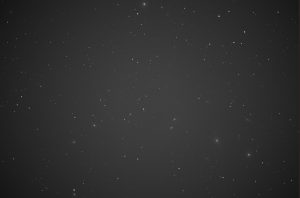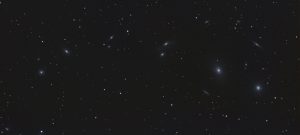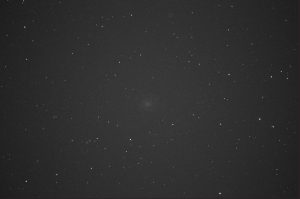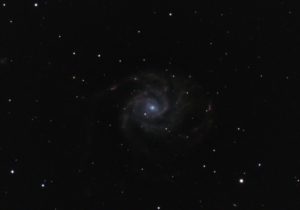Introduction
This post documents my first attempts at astrophotography with the Celestron CPC 1100 GPS telescope and the Hyperstar imaging system. My first targets were Markarian’s Chain and the Pinwheel galaxy (M101). Unfortunately, the targets were captured in an environment polluted by lights from a neighboring high school and multiple street lights. The remainder of this post describes the equipment used, the process used to capture and improve them and the images captured.
Equipment
The main equipment used to capture Markarian’s Chain and M101 was a Celestron CPC 1100 GPS telescope, the Hyperstar 3 system and a ZWO ASI071MC Pro camera. In this configuration, the CPC 1100 becomes a 560mm focal length f/2 system. The telescope was mounted on the Celestron HD Pro Wedge which increased tracking accuracy allowing for longer exposures. The camera was connected via USB 3.0 to a laptop running Nebulosity 4 for image capture. The resulting images were processed using Photoshop.
Capturing and Pre-processing Images
Target images contain the desired signal as well as noise from several sources: bias, thermal and optical system imperfections. Bias noise represents the electronic signature of the camera. Thermal noise becomes more evident with long exposure times and warm sensors. Optical system imperfections include vignetting and other characteristics specific to a particular optical system. Many target and calibration images are taken, processed and combined to reduce noise. This section describes the images that are captured and the processing necessary to yield results.
Bias Frames
As previously mentioned, bias noise is created by the electronics of the camera used to capture the images of interest. By capturing short exposure images with the camera’s lens cap on, they contain little noise from thermal or optical issues. These images are collected with the same camera gain used to collect target images. The bias frames collected are averaged to create a master bias frame. How this master bias frame is used during processing will be described shortly. It is important to point out that every frame contains bias noise regardless of exposure time or how cool the sensor is kept.
Dark Frames
Dark frames contain both bias and thermal noise. They are acquired by placing the lens cap on the camera and taking exposures equivalent to those used to acquire the target images. It is ideal to have the camera at the same temperature, use the same gain and the same exposure times that were used to capture the target sub-images. Like bias frames, these frames are averaged resulting in a master dark frame.
Flat Frames
Flat frames contain bias noise as well as artifacts of the optical system. These artifacts include vignetting, dust on lenses, mirrors and sensors, and other optical system imperfections. While there are multiple ways to collect these frames, I use the t-shirt method. I place two layers of a white t-shirt over the aperture of the telescope and take numerous exposures. The focus and orientation of the camera to the optical system are kept consistent with those used when the target images were collected. The exposure times are controlled to give reasonable exposures.
Sub-Exposures or Subs
The sub-exposures, or subs, are the acquired images of the target object including the described noise and imperfections. The optimum exposure time for subs is a hotly debated topic in numerous forums. Too short and the images contain too much read noise to result in good quality finished products. Too long, in areas like mine, and they are washed out from light pollution. Exposure times between 2 and 20 minutes seem common with the average being in the 3-5 minute range. Given that this f/2 system is 8-10 faster than most others, I use exposure times considerably shorter.
Pre-processing
The noise components of captured images cannot simply be subtracted resulting in a noise-free result, but the solution isn’t that much more complicated. One of the complications is that bias noise is contained in all captured frames. Let’s first consider the flats and the elimination of vignetting.
Flats contain data characterizing the optical issues of a particular system as well as bias noise. We begin by subtracting the master bias frame from each flat frame. The resulting flat frames have little thermal noise because they were acquired with short exposure times and the bias noise has been subtracted. The resulting frames are averaged to create a master flat frame.
The master dark frame, described above, is subtracted from each of the subs. The result is a set of images that contain target data and ideally no bias or thermal noise. Each of these frames is then divided by the master flat frame to remove the imperfections of the optical system. The result is a set of subs that ideally contain no noise or optical imperfections.
These subs are then de-mosaiced, converted to a full-color image, aligned, rotated and scaled using star images and averaged. The result is a single output image file with a much higher signal to noise ratio that can be post-processed to yield good results.
First Targets
The two targets of interest were Markarian’s Chain and the Pinwheel galaxy (M101). This section describes the subs taken and shows the results after post-processing in Photoshop.
Markarian’s Chain
The Markarian’s Chain sub-exposures were acquired using 50 second exposure times with a camera gain of 94 (unity gain).  The figure to the right is one of the 110 sub-exposures. The most significant visual issue is the significant vignetting. In addition, these exposures are likely too long given the conditions. Future attempts will be made with more subs, but shorter exposure times.
The figure to the right is one of the 110 sub-exposures. The most significant visual issue is the significant vignetting. In addition, these exposures are likely too long given the conditions. Future attempts will be made with more subs, but shorter exposure times.
Bias, dark and flat frames were collected and used to process these sub-exposure frames. The result was a single pre-processed image file that represented just over 1.5 hours of total exposure time. This image was processed using Photoshop resulting in my first finished product illustrated below.
The technical aspects of creating such an image are interesting to me, but in addition, I am always moved by the sheer immensity of space and the beauty of the creation. This image contains at least 10 galaxies each of which contains hundreds of millions of stars, that’s simply amazing and inspiring!
The Pinwheel Galaxy (M101)
The Pinwheel galaxy is located near the handle of the big dipper and was an enjoyable target to witness for the first time. Each sub-exposures was  acquired with a 5 second exposure time with a camera gain of 200 and an offset of 50. The figure to the right is one of the 120 sub-exposures. The most significant visual issue is again the significant vignetting. In addition, there is significant noise due to the high gain used. In the future, I am unlikely to use gains greater than unity.
acquired with a 5 second exposure time with a camera gain of 200 and an offset of 50. The figure to the right is one of the 120 sub-exposures. The most significant visual issue is again the significant vignetting. In addition, there is significant noise due to the high gain used. In the future, I am unlikely to use gains greater than unity.
As with the Markarian’s Chain images, bias, dark and flat frames were collected and used to process the M101 sub-exposure frames. The result was a single pre-processed image file that represented 10 minutes of total exposure time. This image was processed using Photoshop resulting in the finished product illustrated below.
I look forward to targetting M101 again and experimenting with longer exposure times and perhaps capturing many more sub-exposures.
Summary
I am captivated by both the beauty of the universe and the technical aspects of capturing it. I can hardly wait for the next clear night and the opportunity that it will give me to capture more. I look forward to experimenting with more sub-exposures and varying exposure times. I look forward to experiencing the system in its f/7.5 configuration to increase magnification. While this will increase exposure time significantly, the challenge will be fun. Finally, I look forward to summer and fall and the new targets they’ll bring.
